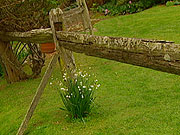Fernbrook Garden
Les Musgrave designed Fernbrook garden and gallery in Sydney’s lower Blue Mountains as an early spring garden, so that he can enjoy an extended flowering period during this wonderful time of the year. Visitors can’t help being inspired when they see the range of plants that are thriving at Fernbrook, including quite a few that are considered very difficult to grow. Don was very impressed by a whole stand of waratahs which will look stunning when they burst into bloom! He also loved the many perfumed species, such as daphne, osmanthus and magnolia. Blossom trees also feature at this time including winter flowering peaches (Prunus persica) and Prunus ‘Okame’.
Daphne (Daphne odora)
Daphnes are mass planted at Fernbrook, and scent the air throughout the garden. Daphnes have a reputation for being very touchy plants. They often drop dead suddenly because they carry virus diseases, which reduce their vigour and make them more susceptible to root rot. A healthy, virus-free daphne will have uniformly dark green, glossy leaves that grow horizontally from the stem. Daphnes grow well in cool, sheltered positions. They need perfect drainage, so are best planted on a sloping site or in a raised bed where the soil has been built up by about 20-30cm (8-12"). If this is not possible a pot is the next best alternative.
Yulan magnolia (Magnolia denudata)
The creamy white, waxy flowers of the Yulan magnolia appear at the end of winter on bare branches. These flowers are goblet shaped, and have a subtle, lemon fragrance. Magnolia denudata grows to around 10m (30′) tall.
Osmanthus (Osmanthus fragrans and new hybrids of O. delavayi)
The flowers of osmanthus are small and insignificant to look at, but they have a delightful apricot fragrance. As well as the species, some of the new varieties of osmanthus are growing at Fernbrook. ‘Pearly Gates’ and ‘Heaven Scent’, varieties of O. delavayi, have serrated evergreen leaves and large tubular white flowers with a strong, sweet perfume. They flower in late winter to early spring. Osmanthus prefers the cool, moist parts of Australia, but thrives from the subtropics (Brisbane and Perth) to Hobart.
Special effects
At Fernbrook there are some interesting ideas and theatrical effects that visitors can have lots of fun trying out in their own gardens. Don looked at just a few examples:
Instead of removing large rocks in the lawn, the grass has been mown and trimmed around them. Mosses and lichens have grown on the rocks, creating a wonderful mottled effect. An old timber fence adds great charm to the garden. Underneath the fence clumps of snowflakes herald the spring. Snowflakes (Leucojum aestivum) have charming white flowers with green spots. They are very hardy, and look great mass planted under deciduous trees.
Further information
Our segment was filmed at:
Fernbrook Garden
2 Queen Street
Kurrajong Heights, NSW, 2758
The garden and gallery are about 90 minutes from Sydney and are open from Thursday to Sunday. For more information phone (02) 4567 7330.
Three gardens at Kurrajong Heights, ‘Fernbrook’, ‘Tiverton’ and ‘Yandra’ will be open for Australia’s Open Garden Scheme on 14-15 October, 2000, 10am-4.30pm. Joint fee $10.60 for three gardens. For more details call the information line on 1900 155 064 in the week before the opening or see the AOGS Guidebook 2000/2001 ($14.95 from ABC shops and bookshops).



